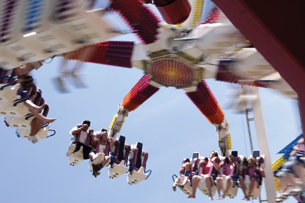Module 5—Circular Motion
 Reflect and Connect
Reflect and Connect

© Steven Pepple/shutterstock
When engineers designed the ride pictured here, they set up the passenger seating so that everyone would be facing inward. This was intentional. The inward (centripetal) force will be significant; so, pushing from behind is the safest way to apply this force in these circumstances. The tension in the arms of the structure produces the inward force, which acts on the passengers and forces them to travel in a circle. The ride will also have a maximum safe speed, which is based on the amount of tension that can be applied in the structure and handled by the riders. This is also considered when determining the length of each arm that holds the seats. When loading passengers, the operators have to be careful to balance the mass in the system. As well, keeping an equal number of riders on each swing is important to maintain an equal tension in each of the arms of the spinning ride. At higher speeds, things gets exciting, with the inward force accelerating the passengers from behind and constantly changing the direction of their velocity as they see the world below spinning quickly. It is the acceleration that puts the thrill in the ride and makes the engineering specifications so detailed.
Compare this design to that of the Polar Express ride, where passengers face the direction of travel rather than the centre of the circular path. In such a case, the maximum inward force will be much smaller so that the outside rider is squished, but not crushed, by those on the inside.
Answer the following question, and store your answer in your Physics 20 course folder: How do the ride engineers and operators ensure the inward force is smaller on rides such as the Polar Express?
 Reflect on the Big Picture
Reflect on the Big Picture
Each of the Reflect on the Big Picture sections in this module will ask you to consider the movement of objects in a circle or part of a circle. To help you reflect on your learning from this lesson, complete at least one of these reflection activities:
- You’ve read about carnival rides that spin and push people to the outside. You’ve likely experienced the same forces just riding around in cars or buses. Create a poem or short story about being pushed around by these invisible forces. Present your creation in either an oral or written form.
- You’ve probably heard someone say that watching a spinning skater makes them dizzy. Research how skaters doing rapid spins overcome such dizziness, and write a short report on it. You may choose to share your research with others in the discussion area and use any comments you get from your classmates to assist you in writing your report.
 Module 5: Lesson 1 Assignment
Module 5: Lesson 1 Assignment
Remember to submit the Module 5: Lesson 1 Assignment to your teacher.